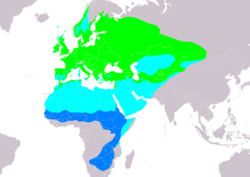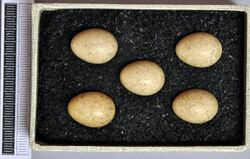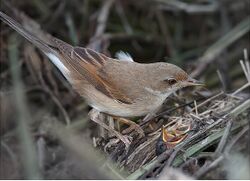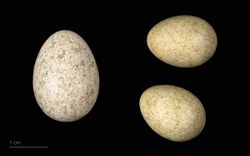Biology:Common whitethroat
| Common whitethroat | |
|---|---|

| |
| File:Common Whitethroat (Sylvia communis) (W1CDR0001503 BD6).ogg | |
| Scientific classification | |
| Domain: | Eukaryota |
| Kingdom: | Animalia |
| Phylum: | Chordata |
| Class: | Aves |
| Order: | Passeriformes |
| Family: | Sylviidae |
| Genus: | Curruca |
| Species: | C. communis
|
| Binomial name | |
| Curruca communis (Latham, 1787)
| |

| |
| Range of C. communis Breeding Passage Non-breeding
| |
| Synonyms | |
|
Sylvia communis Latham, 1787 | |
The common whitethroat or greater whitethroat (Curruca communis) is a common and widespread typical warbler which breeds throughout Europe and across much of temperate western Asia. This small passerine bird is strongly migratory, and winters in tropical Africa, Arabia, and Pakistan .
Taxonomy
The English ornithologist John Latham described the common whitethroat in 1783 in his A General Synopsis of Birds but introduced the binomial name Sylvia communis in the supplement to this work which was published in 1787.[3][4] The specific communis is Latin for "common".[5] The common whitethroat is now placed in the genus Curruca that was introduced by the German naturalist Johann Matthäus Bechstein in 1802.[6][7]
This species may appear to be closely related to the lesser whitethroat, the species having evolved only during the end of the last ice age similar to the willow warbler and chiffchaffs. However, researchers found the presence of a white throat is an unreliable morphological marker for relationships in Curruca, and the greater and lesser whitethroats are not closely related.[8][9] A molecular phylogenetic study of the Sylviidae published in 2011 found that within the genus Curruca the common whitethroat and the lesser whitethroat are members of different clades and are thus not sister species.[10]
Four subspecies are recognised:[7]
- C. c. communis (Latham, 1787) – breeds in Europe to north Turkey and north Africa; winters in west and central Africa
- C. c. volgensis (Domaniewski, 1915) – breeds in southeast European Russia, west Siberia and north Kazakhstan; winters in east and south Africa
- C. c. icterops (Ménétries, 1832) – breeds in central Turkey to Turkmenistan and Iran; winters in east and south Africa
- C. c. rubicola (Stresemann, 1928) – breeds in mountains of central Asia; winters in east and south Africa
Description
This is one of several Curruca species that has distinct male and female plumages. Both sexes are mainly brown above and buff below, with chestnut fringes to the secondary remiges. The adult male has a grey head and a white throat. The female lacks the grey head, and the throat is duller.
The whitethroat's song is fast and scratchy, with a scolding tone. The hoarse, slightly nasal, call sounds like wed-wed or woid-woid. The warning cry is long-pulled, rough tschehr which resembles that of the Dartford warbler.
Distribution and habitat
This is a bird of open country and cultivation, with bushes for nesting. The nest is built in low shrub or brambles, and 3–7 eggs are laid. Like most warblers, it is insectivorous, but will also eat berries and other soft fruit.
In Europe, western and eastern populations of common whitethroats have contrasting moulting and pre-migratory fueling strategies to capitalise on food supplies before departing their breeding and non-breeding grounds.[11]
References
- ↑ BirdLife International (2019). "Curruca communis". IUCN Red List of Threatened Species 2019: e.T22716910A155623300. doi:10.2305/IUCN.UK.2019-3.RLTS.T22716910A155623300.en. https://www.iucnredlist.org/species/22716910/155623300. Retrieved 21 October 2022.
- ↑ Mayr, Ernst; Cottrell, G. William, eds (1986). Check-List of Birds of the World. 11. Cambridge, Massachusetts: Museum of Comparative Zoology. pp. 273–274. https://www.biodiversitylibrary.org/page/14483974.
- ↑ Latham, John (1783). A General Synopsis of Birds. 2, Part 1. London: Printed for Leigh and Sotheby. pp. 428–429. http://biodiversitylibrary.org/page/33730507.
- ↑ Latham, John (1787). Supplement to the General Synopsis of Birds. London: Printed for Leigh & Sotheby. p. 287. http://biodiversitylibrary.org/page/33046886.
- ↑ Jobling, James A (2010). The Helm Dictionary of Scientific Bird Names. London: Christopher Helm. pp. 115, 376. ISBN 978-1-4081-2501-4. https://archive.org/details/Helm_Dictionary_of_Scientific_Bird_Names_by_James_A._Jobling.
- ↑ Bechstein, Johann Matthäus (1802) (in German). Ornithologisches Taschenbuch von und für Deutschland, oder, Kurze Beschreibung aller Vögel Deutschlands für Liebhaber dieses Theils der Naturgeschichte. Leipzig: Carl Friedrich Enoch Richter. p. 165. https://www.biodiversitylibrary.org/page/41098775.
- ↑ 7.0 7.1 Gill, Frank; Donsker, David; Rasmussen, Pamela, eds (January 2021). "Sylviid babblers, parrotbills, white-eyes". IOC World Bird List Version 11.1. International Ornithologists' Union. https://www.worldbirdnames.org/bow/sylvias/.
- ↑ Helbig, A. J. (2001): Phylogeny and biogeography of the genus Sylvia. In: Shirihai, Hadoram: Sylvia warblers: 24–25 Princeton University Press, Princeton, N.J. ISBN:0-691-08833-0
- ↑ Dietzen, C.; Garcia-del-Rey, E.; Castro, G.D.; Wink, M. (2008). "Phylogenetic differentiation of Sylvia species (Aves: Passeriformes) of the Atlantic islands (Macaronesia) based on mitochondrial DNA sequence data and morphometrics". Biological Journal of the Linnean Society 95 (1): 157–174. doi:10.1111/j.1095-8312.2008.01005.x.
- ↑ Voelker, Gary; Light, Jessica E. (2011). "Palaeoclimatic events, dispersal and migratory losses along the Afro-European axis as drivers of biogeographic distribution in Sylvia warblers". BMC Evolutionary Biology 11 (163): 163. doi:10.1186/1471-2148-11-163. PMID 21672229.
- ↑ Remisiewicz, M.; Bernitz, Z.; Bernitz, H.; Burman, M.S.; Raijmakers, J.M.H.; Raijmakers, H.F.A.; Underhill, L.G.; Rostkowska, A. et al. (2019). "Contrasting strategies for wing‐moult and pre‐migratory fuelling in western and eastern populations of Common Whitethroat Sylvia communis". Ibis 161 (4): 824–838. doi:10.1111/ibi.12686.
Further reading
- Shirihai, Hadoram; Gargallo, Gabriel; Helbig, Andreas J. (2001). Sylvia Warblers: Identification, Taxonomy and Phylogeny of the Genus Sylvia. London: Christopher Helm. ISBN 978-071363984-1.
External links
| Wikimedia Commons has media related to Sylvia communis. |
- Ageing and sexing (PDF; 4.0 MB) by Javier Blasco-Zumeta & Gerd-Michael Heinze
- Avibase[yes|permanent dead link|dead link}}]
- Common whitethroat – Species text in The Atlas of Southern African Birds.
Wikidata ☰ Q110257516 entry
 |





